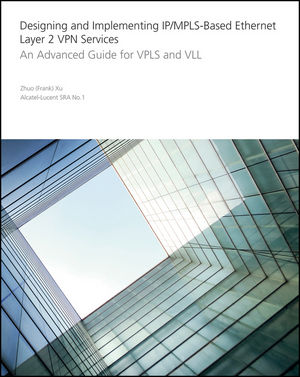Designing and Implementing IP/MPLS-Based Ethernet Layer 2 VPN Services: An Advanced Guide for VPLS and VLLISBN: 978-0-470-45656-9
Paperback
984 pages
December 2009
 This is a Print-on-Demand title. It will be printed specifically to fill your order. Please allow an additional 10-15 days delivery time. The book is not returnable.
|
||||||
Introduction.
Part 1 IP/MPLS VPN Service Network Overview.
Chapter 1 Building Converged Service Networks with IP/MPLS VPN Technology.
1.1 The Increasing Demands on Service Provider Networks.
1.2 MPLS Overview.
1.3 The MPLS Value Proposition.
1.4 MPLS Enables Converged Multi-Service Networks.
1.5 MPLS-Enabled Business VPN Services.
Summary.
Chapter 2 IP/MPLS VPN Multi-Service Network Overview.
2.1 IP/MPLS Layer 2 VPN Requirements.
2.2 IP/MPLS Layer 2 VPN Services.
2.3 Meeting the Service Network Requirements Using IP/MPLS VPN Architecture.
2.4 IP/MPLS VPN-Enabled Applications.
Summary.
Part II IP/MPLS VPN Protocol Fundamentals.
Chapter 3 Using MPLS Label Switched Paths as Service Transport Tunnels.
3.1 Basic MPLS Concepts Review.
3.2 Label Switch Path Types.
3.3 LDP-LSP — LDP Label Distribution.
3.4 RSVP-TE LSPs.
3.5 Confi guring RSVP-TE LSP.
Summary.
Chapter 4 Routing Protocol Traffi c Engineering and CSPF.
4.1 Introducing Traffi c Engineering.
4.2 Introducing OSPF-TE.
4.3 Introducing IS-IS TE.
4.4 The CSPF Algorithm.
4.5 RSVP-TE LSP Policy Control: Administrative Groups and SRLG Groups.
Summary.
Chapter 5 RSVP-TE Protocol.
5.1 RSVP and RSVP-TE.
5.2 RSVP-TE Signaling Procedure.
5.3 RSVP-TE Messages and Objects.
5.4 Make-Before-Break (MBB).
5.5 The RSVP-TE Hello Protocol.
5.6 Reducing RSVP Refresh Overhead.
5.7 RSVP MD5 Authentication.
Summary.
Chapter 6 MPLS Resiliency — Secondary LSP.
6.1 Ensuring Reliability with MPLS Resiliency.
6.2 An Overview of Primary and Secondary LSPs.
6.3 What Affects Convergence Performance?
6.4 Rules for Selecting Secondary LSPs.
6.5 Case Study: Using Administrative Groups in Secondary LSPs.
Summary.
Chapter 7 MPLS Resiliency — RSVP-TE LSP Fast Reroute.
7.1 RSVP-TE LSP Resiliency.
7.2 Fast Reroute Overview.
7.3 Fast Reroute Architecture.
7.4 One-to-One Backup.
7.5 Facility Backup.
7.6 Manual Bypass Tunnel.
Summary.
Chapter 8 Label Distribution Protocol.
8.1 LDP Overview.
8.2 LDP Session Establishment and Management.
8.3 Using T-LDP to Signal Pseudowires for Layer 2 VPN Services.
8.4 LDP Messages and TLVs.
8.5 LDP over RSVP-TE Tunneling.
Summary.
Part III Ethernet VPN Services.
Chapter 9 IP/MPLS VPN Service Routing Architecture.
9.1 IP/MPLS VPN Service Network Infrastructure.
9.2 Alcatel-Lucent Service Routing Architecture.
9.3 Service Access Point and SAP Components.
9.4 Service Distribution Paths and Transport Tunnels.
9.5 Multiple Forwarding Paths in the Same SDP.
9.6 Maximum Transmission Unit in a Service Network.
9.7 IP/MPLS VPN Service Implementation Overview.
Summary.
Chapter 10 Virtual Leased Line Services.
10.1 VLL Services Overview.
10.2 VLL Services Architecture.
10.3 Pseudowire Switching for VLL Services.
10.4 VLL Example: Epipe — Ethernet P2P VPN.
10.5 VLL Connection Admission Control.
Summary.
Chapter 11 Virtual Private LAN Service.
11.1 VPLS Service Overview.
11.2 VPLS Architecture.
11.3 VPLS Mesh-Pseudowires.
11.4 VPLS Service Access Points.
11.5 VPLS Forwarding Database Management.
Summary.
Chapter 12 Hierarchical VPLS.
12.1 Hierarchical-VPLS Overview.
12.2 Spoke-Pseudowire Details.
12.3 H-VPLS Topologies.
12.4 H-VPLS Design Case Study — Where to Break the Mesh?
Summary.
Chapter 13 High Availability in an IP/MPLS VPN Network.
13.1 Building a Network with High Availability.
13.2 Bidirectional Forwarding Detection.
13.3 Link Aggregation Group Overview.
13.4 Multi Chassis Link Aggregation Group.
13.5 Traffi c Load Balancing in Link Aggregation Groups.
Summary.
Chapter 14 VLL Service Resiliency.
14.1 VLL Service Resiliency Overview.
14.2 VLL Service Resiliency Using Pseudowire Redundancy.
14.3 VLL Network Design Using MC-LAG with Pseudowire Redundancy.
Summary.
Chapter 15 VPLS Service Resiliency.
15.1 Introduction to VPLS Service Resiliency.
15.2 Access Resiliency.
15.3 H-VPLS Backbone Resiliency.
15.4 Using MAC-Flush to Avoid Blackholes.
Summary.
Part IV Advanced Ethernet VPN Topics.
Chapter 16 VPLS BGP Auto-Discovery.
16.1 VPLS BGP-AD Overview.
16.2 BGP Auto-Discovery for LDP-VPLS.
16.3 SDPs, Transport Tunnels, and Pseudowires Created Using BGP-AD.
16.4 Using Pre-Provisioned SDPs.
16.5 Using BGP-AD Import and Export Policies to Control the Forwarding Topology of VPLS.
Summary.
Chapter 17 PBB-VPLS.
17.1 Provider Backbone Bridge Overview.
17.2 PBB-VPLS Architecture.
17.3 PBB-VPLS Learning and Forwarding.
17.4 Controlling Flooding in PBB-VPLS.
17.5 FDB Management in I-VPLS and B-VPLS.
17.6 OAM in a PBB-VPLS Network.
17.7 Service Resiliency in PBB-VPLS Networks.
17.8 MAC-Flush in PBB-VPLS.
17.9 PBB Epipe.
Summary.
Chapter 18 OAM in a VPLS Service Network.
18.1 OAM Functional Overview.
18.2 Ethernet in the First Mile (EFM) OAM (802.3ah).
18.3 Ethernet Connectivity Fault Management.
18.4 OAM in an IP/MPLS VPN Service Network.
18.5 OAM in VPLS Services.
Summary.
Appendix A Spanning Tree Protocol.
A.1 Spanning Tree Protocol.
A.2 Spanning Tree Protocol Variations.
A.3 VPLS Service Loop Prevention with STP.
A.4 Altered STP Behavior in the VPLS Core.
A.5 Using VPLS STP to Eliminate Customer Forwarding Loops.
A.6 Using VPLS STP to Block Redundant Spoke-Pseudowires in H-VPLS.
A.7 LDP MAC-Flush in STP Convergence.
A.8 Management VPLS.
Appendix B RFC and IEEE Standards.
Glossary.
Index.



